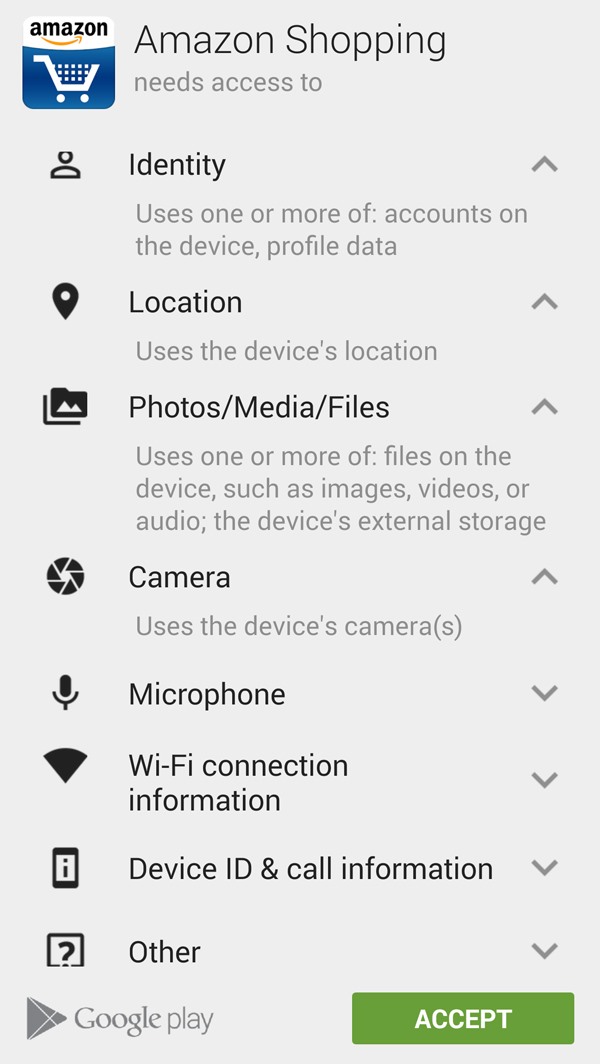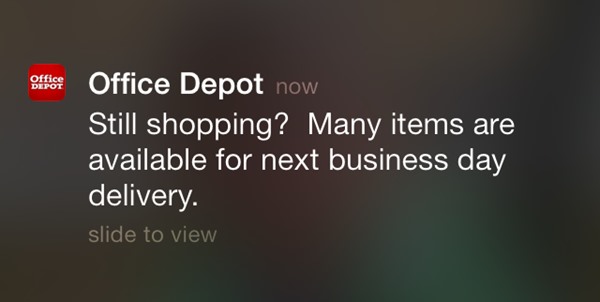How To Drive ROI and Revenue from Your Mobile Marketing
Mobile can help your company bridge the gap between the online and offline experiences that your audience is having with your organization, but it’s one thing to build a dedicated community on mobile and yet another to drive these customers to action and purchase your products.
Here’s how you can drive action from your customers and better achieve measurable results through your mobile marketing efforts.
Develop a Mobile Retail App
When compared with a mobile friendly website, a mobile retail application can often be more effective in encouraging customer action and ROI for your company. This is because mobile apps are downloaded directly to your customer’s device and you’ll have the opportunity to gather more consumer data. This data can help you make informed marketing decisions that improve your mobile campaigns.
For example,the mobile Amazon Shopping app asks for a laundry list of user data prior to installing on their customer’s device. With this information, Amazon can get a better understanding of who is installing their app and have better insight into how their audience is interacting with their mobile offerings.

Collecting and analyzing this data can prove essential when you adapt your marketing message and optimize your sales funnels to entice users to make purchases down the road. In addition to increased user data, mobile applications can provide a variety of other benefits that should not be overlooked, these include:
- The best native experience on mobile devices; a user experience that you can control 100%.
- Access to smartphone features and tools such as the camera and GPS (for location based alerts)
- Push notifications to send direct marketing messages to urge action.
Enable Behavioral and Location Based Messaging
Push notifications can allow retail marketers to provide current and relevant information directly to their customers, which can encourage engagement and spur consumer action such as, app launches or product purchases. This can be accomplished by sending your customers a personalized message based on the actions that they have made while using your mobile application.
For example, Office Depot triggers the following push notification to address a customer that has completed the action of adding items to their shopping cart, yet have failed to complete the desired conversion of making a purchase.

Office Depot delivers push notification messages to spur customers to purchase.
By enabling a behavioral push notification to trigger upon an abandoned shopping cart, Office Depot has taken action to try and recover lost sales opportunities. Some ecommerce companies have experienced an increase of 278% more app launches among users that have push notifications enabled, which can improve the likelihood that their customers reopen their mobile app and complete their transaction.
Start by incorporating push notifications into you mobile marketing strategy and test a variety of different messages that relate to your business needs and conversion goals. Through testing, you’ll begin to find the types of notifications that resonate best with your audience and create more sales opportunities. Consider the following tactics when developing a push notification strategy:
- Notify a user when a recently viewed product goes on sales or is featured in a review.
- Prompt customers to visit your brick-and-mortar stores when they reach a certain proximity by leveraging mobile GPS tracking.
- Re-engage a user by notifying them if they haven’t opened your application within a designated time period.
- MeasureROI Through Reporting and Analytics
One of the most important elements to driving ROI and revenue is understanding which tactics effectively move the needle for your company. While collecting the correct data to prove this is often easier said than done, it is essential in building a more accurate understanding of how your mobile marketing can have a lasting influence.

Mobile app analytics are critical when determining the effectiveness of your mobile efforts.
Startby analyzing your mobile campaigns at least once a week and identify any trends in your data. Note app opens, average time in app, push notification open rates and the times of day when your mobile content is most and least effective.
With this data, you can begin to discover the best times to deliver your marketing message to your mobile users and find which messaging tactics resonate more with your audience. For example, a push notification that is sent during a customer’s dinner hours may be ignored whereas that same message may have been actionable if delivered during their lunch break. The correct data should reveal this type of information.
For retailers with brick-and-mortar stores, look to connect your mobile data to point-of-sale activity and loyalty card use when applicable. This is likely to require careful planning with your app development, marketing and data scientist teams, but this information can help you better understand the correlation between your mobile campaigns and offline transactions.
About eTail: eTail is an interactive conference focused on intimate group learning and peer to peer networking. The “X Factor” of a conference experience is the interaction of thousands of peers, and eTail presents the unique opportunity to exchange information and ideas with the brightest minds in the industry. We've put together a great program chock full of networking opportunities and industry specific, and actionable insight.

About Brian Honigman: Brian Honigman is a content marketing consultant and the CEO of Honigman Media. He's a regular contributor to the Wall Street Journal, Forbes and others. Follow him on Twittertarget="_blank">@BrianHonigman